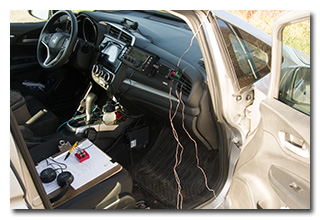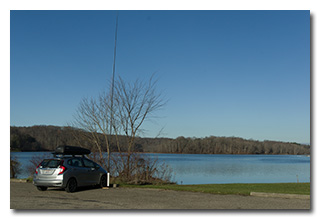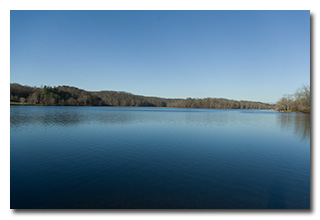Description
On Friday, December 8, 2023, one member of the Southeast Ohio Radio Adventure Team performed a successful activation of Lake Logan State Park in Ohio as part of the Parks on the Air (POTA; link) program.
While on his way to Newark to visit his parents, Eric McFadden, WD8RIF, stopped at the fishing peninsula on the east shore of Lake Logan to perform a quick activation.
Arriving at the fishing peninsula at about 1350 UTC, Eric found the area to be completely empty. Selecting an out-of-the-way place to park, Eric deployed his 28½' wire vertical on his 31' Jackite telescoping fiberglass mast on his drive-on base. Mounting his Elecraft KX3 on his car's dashboard, Eric was on the air at 1358 UTC.
As at his previous activations of this park, Eric had good cell-signal at this location, and he would be able able to spot himself on POTA Spots (link) and to use POTA Spots to identify possible park-to-park (P2P) QSO opportunities.
Despite having S6 atmospheric noise on the band, Eric began his operation on 20m. Finding himself a frequency to run, Eric spotted himself to POTA Spots and began calling CQ. His first QSO came at 1400 UTC with NE5A in Oklahoma. Despite the high noise-floor, QSOs came very quickly, with Eric's seventeenth QSO coming at 1420 UTC with K5UNY in Texas. This run included QSOs with operators located in Oklahoma (2), Texas (5), Florida (3), New Mexico, New York, Mississippi, Georgia (2), Alabama, and Minnesota.
Eric finished his operation by checking POTA Spots for P2P QSO opportunities. At 1353 UTC he completed a P2P QSO on 20m with NS1C at Fort Revere Park State Park (K-8386) in Massachussetts. At 1357 UTC he completed a P2P QSO on 20m with WB0RLJ at Chalco Hills State Recreation Area (K-4011) in Nebraska.
In all, Eric made seventeen QSOs in just about twenty-two minutes of on-air time. All of Eric's QSOs were CW and were made with five watts output.
Eric also submitted his log to the World Wide Flora and Fauna in Amateur Radio (WWFF; link) program.
(return)



